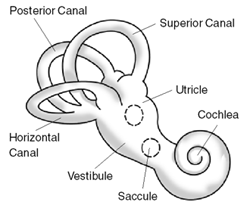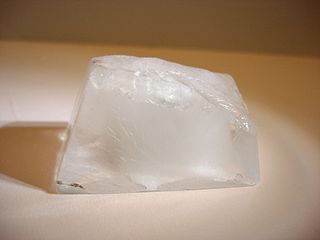Ataxia is a neurological sign consisting of lack of voluntary coordination of muscle movements that can include gait abnormality, speech changes, and abnormalities in eye movements, that indicates dysfunction of parts of the nervous system that coordinate movement, such as the cerebellum.
This is a glossary of medical terms related to communication disorders which are psychological or medical conditions that could have the potential to affect the ways in which individuals can hear, listen, understand, speak and respond to others.

Ménière's disease (MD) is a disease of the inner ear that is characterized by potentially severe and incapacitating episodes of vertigo, tinnitus, hearing loss, and a feeling of fullness in the ear. Typically, only one ear is affected initially, but over time, both ears may become involved. Episodes generally last from 20 minutes to a few hours. The time between episodes varies. The hearing loss and ringing in the ears can become constant over time.
A balance disorder is a disturbance that causes an individual to feel unsteady, for example when standing or walking. It may be accompanied by feelings of giddiness, or wooziness, or having a sensation of movement, spinning, or floating. Balance is the result of several body systems working together: the visual system (eyes), vestibular system (ears) and proprioception. Degeneration or loss of function in any of these systems can lead to balance deficits.
Mal de debarquementsyndrome is a neurological condition usually occurring after a cruise, aircraft flight, or other sustained motion event. The phrase "mal de débarquement" is French and translates to "illness of disembarkment". MdDS is typically diagnosed by a neurologist or an ear nose and throat specialist when a person reports a persistent rocking, swaying, or bobbing feeling. This usually follows a cruise or other motion experience. Because most vestibular testing proves to be negative, doctors may be baffled as they attempt to diagnose the syndrome. A major diagnostic indicator is that most patients feel better while driving or riding in a car, i.e, while in passive motion. MdDS is unexplained by structural brain or inner ear pathology and most often corresponds with a motion trigger, although it can occur spontaneously. This differs from the very common condition of "land sickness" that most people feel for a short time after a motion event such as a boat cruise, aircraft ride, or even a treadmill routine which may only last minutes to a few hours. Since 2020, the syndrome has recently received increased attention due to the number of people presenting with the condition, and more scientific research has commenced in determining what triggers MdDS and how to cure it. This is also due to the fact that MdDs is now officially recognized (2020).

The vestibular system, in vertebrates, is a sensory system that creates the sense of balance and spatial orientation for the purpose of coordinating movement with balance. Together with the cochlea, a part of the auditory system, it constitutes the labyrinth of the inner ear in most mammals.

Labyrinthitis is inflammation of the labyrinth, a maze of fluid-filled channels in the inner ear. Vestibular neuritis is inflammation of the vestibular nerve. Both conditions involve inflammation of the inner ear. Labyrinths that house the vestibular system sense changes in the head's position or the head's motion. Inflammation of these inner ear parts results in a sensation of the world spinning and also possible hearing loss or ringing in the ears. It can occur as a single attack, a series of attacks, or a persistent condition that diminishes over three to six weeks. It may be associated with nausea, vomiting, and eye nystagmus.

Benign paroxysmal positional vertigo (BPPV) is a disorder arising from a problem in the inner ear. Symptoms are repeated, brief periods of vertigo with movement, characterized by a spinning sensation upon changes in the position of the head. This can occur with turning in bed or changing position. Each episode of vertigo typically lasts less than one minute. Nausea is commonly associated. BPPV is one of the most common causes of vertigo.

Pagophagia is the compulsive consumption of ice or iced drinks. It is a form of the disorder known as pica, which in Latin refers to a magpie that eats everything indiscriminately. Its medical definition refers to the persistent consumption of nonnutritive substances for over a period of at least one month. However, different studies have included alternative definitions including "daily consumption of 2-11 full glasses of ice (480-2640g)" or "the purposeful ingestion of at least one ordinary tray of ice daily for a period in excess of two months." Pagophagia has been shown to be associated with iron-deficiency anemia and responsive to iron supplementation, leading some investigators to postulate that some forms of pica may be the result of nutritional deficiency.

Betahistine, sold under the brand name Serc among others, is an anti-vertigo medication. It is commonly prescribed for balance disorders or to alleviate vertigo symptoms. It was first registered in Europe in 1970 for the treatment of Ménière's disease but current evidence does not support its efficacy in treating it.
Lightheadedness is a common and typically unpleasant sensation of dizziness or a feeling that one may faint. The sensation of lightheadedness can be short-lived, prolonged, or, rarely, recurring. In addition to dizziness, the individual may feel as though their head is weightless. The individual may also feel as though the room is "spinning" or moving (vertigo). Most causes of lightheadedness are not serious and either cure themselves quickly, or are easily treated.

Vertigo is a condition in which a person has the sensation of movement or of surrounding objects moving when they are not. Often it feels like a spinning or swaying movement. This may be associated with nausea, vomiting, sweating, or difficulties walking. It is typically worse when the head is moved. Vertigo is the most common type of dizziness.

The vestibular nerve is one of the two branches of the vestibulocochlear nerve. In humans the vestibular nerve transmits sensory information transmitted by vestibular hair cells located in the two otolith organs and the three semicircular canals via the vestibular ganglion of Scarpa. Information from the otolith organs reflects gravity and linear accelerations of the head. Information from the semicircular canals reflects rotational movement of the head. Both are necessary for the sensation of body position and gaze stability in relation to a moving environment.
The semicircular canal dehiscence (SCD) is a category of rare neurotological diseases/disorders affecting the inner ears, which gathers the superior SCD, lateral SCD and posterior SCD. These SCDs induce SCD syndromes (SCDSs), which define specific sets of hearing and balance symptoms. This entry mainly deals with the superior SCDS.
The spins is an adverse reaction of intoxication that causes a state of vertigo and nausea, causing one to feel as if "spinning out of control", especially when lying down. It is most commonly associated with drunkenness or mixing alcohol with other psychoactive drugs such as cannabis. This state is likely to cause vomiting, but having "the spins" is not life-threatening unless pulmonary aspiration occurs.
Vertiginous epilepsy is infrequently the first symptom of a seizure, characterized by a feeling of vertigo. When it occurs, there is a sensation of rotation or movement that lasts for a few seconds before full seizure activity. While the specific causes of this disease are speculative there are several methods for diagnosis, the most important being the patient's recall of episodes. Most times, those diagnosed with vertiginous seizures are left to self-manage their symptoms or are able to use anti-epileptic medication to dampen the severity of their symptoms.
The righting reflex, also known as the labyrinthine righting reflex, is a reflex that corrects the orientation of the body when it is taken out of its normal upright position. It is initiated by the vestibular system, which detects that the body is not erect and causes the head to move back into position as the rest of the body follows. The perception of head movement involves the body sensing linear acceleration or the force of gravity through the otoliths, and angular acceleration through the semicircular canals. The reflex uses a combination of visual system inputs, vestibular inputs, and somatosensory inputs to make postural adjustments when the body becomes displaced from its normal vertical position. These inputs are used to create what is called an efference copy. This means that the brain makes comparisons in the cerebellum between expected posture and perceived posture, and corrects for the difference. The reflex takes 6 or 7 weeks to perfect, but can be affected by various types of balance disorders.
The term chronic subjective dizziness (CSD) is used to describe a commonly encountered type of dizziness that is not easily categorized into one of several other types, and for which the physical examination is typically normal. Patients with CSD frequently initially suffer a sudden injury of some sort to their vestibular system, the neurologic network that preserves sense of balance. Even after this initial injury has healed, people with CSD usually describe a vague sense of unsteadiness worsened by triggers in their environment such as high places, standing on moving objects, or standing in motion-rich environments like busy streets or crowds. There is a clear indication that anxiety and other mental illnesses play a role in the dizziness symptoms that occur with CSD. However, the condition is categorized as chronic functional vestibular disorder, not as a structural or psychiatric condition.

Vestibular rehabilitation (VR), also known as vestibular rehabilitation therapy (VRT), is a specialized form of physical therapy used to treat vestibular disorders or symptoms, characterized by dizziness, vertigo, and trouble with balance, posture, and vision. These primary symptoms can result in secondary symptoms such as nausea, fatigue, and lack of concentration. All symptoms of vestibular dysfunction can significantly decrease quality of life, introducing mental-emotional issues such as anxiety and depression, and greatly impair an individual, causing them to become more sedentary. Decreased mobility results in weaker muscles, less flexible joints, and worsened stamina, as well as decreased social and occupational activity. Vestibular rehabilitation therapy can be used in conjunction with cognitive behavioral therapy in order to reduce anxiety and depression resulting from an individual's change in lifestyle.
Inner ear decompression sickness, (IEDCS) or audiovestibular decompression sickness is a medical condition of the inner ear caused by the formation of gas bubbles in the tissues or blood vessels of the inner ear. Generally referred to as a form of decompression sickness, it can also occur at constant pressure due to inert gas counterdiffusion effects.








